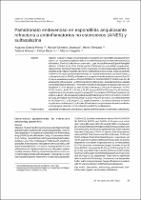Pamidronato endovenoso en espondilitis anquilosante refractaria a antiinflamatorios no esteroideos (AINES) y sulfasalazina
Related Resource(s)
https://revistasinvestigacion.unmsm.edu.pe/index.php/anales/article/view/1239Date
2007-03-19Author(s)
García-Poma, Augusto
Montero-Jauregui, Manuel
Terrazas, Henry
Miraval, Tatiana
Becerra, Felipe
Segami, María I.
Metadata
Show full item recordAlternate title
Intravenous pamidronate in ankylosing spondylitis refractory to nonsteroidal anti-inflammatory drugs (NSAIDs) and sulfasalazine
Abstract
Objetivo: Evaluar la terapia con pamidronato, en pacientes con espondilitis anquilosante (EA) activa, con respuesta subóptima o falla a los antiinflamatorios no-esteroideos (AINES) y sulfasalazina. Diseño: Estudio clínico comparativo. Lugar: Hospital Nacional Edgardo Rebagliati Martins, EsSalud, Lima, Perú. Participantes: Pacientes con espondilitis anquilosante. Intervenciones. Se incluyó 9 pacientes con EA (6 varones), con enfermedad activa (BASDAI ≥4), actividad axial y falta de respuesta a los Aines y sulfasalazina a dosis de 3g/d. Todos los pacientes recibieron 60 mg de pamidronato mensual, en infusión endovenosa, durante 6 meses, y continuaron tomando AINES y sulfasalazina. La mejoría clínica fue evaluada usando el Asas 20. En forma secundaria se evaluó el ASAS 40, BASDAI 50, BASDAI, BASFI Y BASMI, a las 24 y 48 semanas (32 a 86 semanas). La diferencia entre el índice de pre y postratamiento fue evaluada usando la prueba de Wilcoxon. Principales medidas de resultados: Evaluación del ASAS 20. Resultados. El 67% alcanzó un Asas 20 a las 24 semanas y 78% a las 48 semanas; 33,3% y 55,6% tuvieron ASAS 40 y 33,3%; y 44,4% alcanzó BASDAI 50 a las 24 y 48 semanas, respectivamente. Un paciente recayó a la semana 20. Tres pacientes (33,3%) permanecieron sin cambios. A las 24 y 48 semanas, la media de BASDAI disminuyó en 45,1% (p=0,007) y en 52,1% (p=0,01), la media de BASFI en 38,2% (p=0,007) y en 52,3% (p=0,007), y la media de BASMI en 39,2% (p=0,01) y 39,2% (p=0,01), respectivamente. Los eventos adversos no fueron importantes con esta terapia. Conclusiones. El tratamiento con pamidronato demostró ser efectivo en este grupo de pacientes con EA, refractaria a AINES y a sulfasalazina. Objective: To determine the response of an aminobisphosphonate(pamidronate) in patients with ankylosing spondylitis (AS) whohad suboptimal or no response to nonsteroidal anti-inflammatorydrugs (NSAIDs) and sulfasalazine. Design: Comparative clinicalstudy. Setting: Hospital Nacional Edgardo Rebagliati Martins,EsSalud, Lima, Peru. Participants: Patients with ankylosingspondylitis. Intervenciones: Nine patients with AS (6 males), withactive disease [BASDAI ≥4] and no response to NSAIDs andsulfasalazine up to 3g/day entered the study. All patients receivedmonthly infusions of 60 mg of pamidronate for 6 months andremained taking NSAID and sulfasalazine. Clinical improvementwas evaluated using the Assessments in Ankylosing Spondylitis 20 (ASAS 20). Secondary evaluations included ASAS 40, BASDAI50, BASDAI, BASFI, and BASMI at 24 weeks and at lastobservation [48 weeks (32 to 86 weeks)]. Differences betweenpre and post treatment distributions of all continuous indices wereevaluated using the Wilcoxon signed rank test. Main outcomemeasures: Evaluated of ASAS 20. Results: Sixty-seven percentachieved ASAS 20 at 24 weeks and 78% at 48 weeks; 33,3% and55,6% achieved ASAS 40 at 24 and 48 weeks, respectively, and33,3% and 44,4% achieved BASDAI 50 at weeks 24 and 48,respectively. One patient relapsed at week 20. In three patients(33,3%) the scores remained unchanged. At weeks 24 and 48mean BASDAI decreased by 45,1% (p=0,007) and by 52,1%(p=0,01), mean BASFI decreased by 38,2% (p=0,007) and by52,3% (p=0.007), and mean BASMI decreased by 39,2% (p=0,01)and 39,2% (p=0,01), respectively. There were no significantadverse events with this therapy. Conclusions: Our data providefurther evidence of pamidronate therapy effectiveness in patientswith AS who are refractory to NSAIDs and sulfasalazine.
Collections
- Artículos científicos [890]






